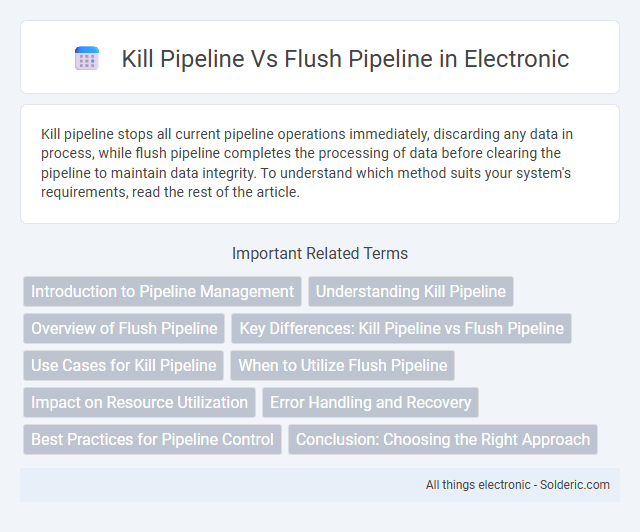Kill pipeline stops all current pipeline operations immediately, discarding any data in process, while flush pipeline completes the processing of data before clearing the pipeline to maintain data integrity. To understand which method suits your system's requirements, read the rest of the article.
Comparison Table
| Feature | Kill Pipeline | Flush Pipeline |
|---|---|---|
| Definition | Immediately stops all pipeline operations and clears all instructions. | Discards current instructions and resets pipeline to start from a specific stage. |
| Purpose | Terminate pipeline due to fatal errors or system halt. | Resolve hazards or incorrect speculative execution by clearing instructions. |
| Effect on Instructions | All in-flight instructions are removed permanently. | Only instructions after a certain point are discarded; others may continue. |
| Pipeline Recovery | Requires re-initialization or restart to resume operation. | Pipeline resumes smoothly from the correct stage after flush. |
| Common Use Case | System crashes, emergency stops. | Branch misprediction correction, hazard resolution. |
Introduction to Pipeline Management
Kill pipeline and flush pipeline are critical techniques in pipeline management used to control instruction flow and mitigate hazards in CPU architecture. Kill pipeline refers to discarding instructions that are no longer needed due to events like branch mispredictions, while flush pipeline clears all instructions in the pipeline to reset the processor state. Understanding these mechanisms helps optimize Your system's performance by minimizing delays and maintaining efficient instruction execution.
Understanding Kill Pipeline
Kill pipeline terminates all ongoing processes immediately, bypassing completion of current instructions, ensuring a rapid halt in execution. This approach contrasts with the flush pipeline method, which allows in-flight instructions to complete before clearing the pipeline. Understanding kill pipeline is crucial for scenarios requiring instant interruption to prevent execution of potentially harmful or erroneous instructions in CPU or GPU architectures.
Overview of Flush Pipeline
Flush pipeline is a processor control mechanism that clears all instructions currently in the pipeline stages to handle mispredicted branches or exceptions. It resets the pipeline to a known state by invalidating in-flight instructions, ensuring correct program execution without committing erroneous operations. This technique minimizes the impact of pipeline hazards, although it may cause performance stalls.
Key Differences: Kill Pipeline vs Flush Pipeline
Kill pipeline immediately terminates all instructions within the pipeline, discarding any partial computations to prevent incorrect results. Flush pipeline clears the pipeline stages by completing or removing instructions that have entered but are not yet committed, ensuring the processor state remains consistent. Unlike kill pipeline, flush pipeline is used primarily to handle branch mispredictions or exceptions without halting processor operation entirely.
Use Cases for Kill Pipeline
Kill pipeline is typically used in scenarios requiring immediate termination of ongoing processes, such as critical system errors or urgent resource reallocation. It ensures all pipeline stages are halted without completing remaining tasks, preventing further execution and potential data corruption. Flush pipeline, by contrast, allows ongoing operations to complete before clearing the pipeline, making kill pipeline the preferred choice for abrupt interruption needs in real-time systems or error recovery.
When to Utilize Flush Pipeline
Flush pipeline is utilized when it is necessary to clear incorrect or partially processed instructions from the pipeline due to branch mispredictions or hazards, ensuring the processor resumes execution with the correct instruction sequence. This method minimizes the impact on performance by selectively clearing instructions beyond the mispredicted branch, allowing for efficient recovery without stalling the entire pipeline. Flushing the pipeline optimizes control flow accuracy and maintains instruction throughput during pipeline hazards.
Impact on Resource Utilization
Kill pipeline abruptly terminates a process, freeing system resources immediately but potentially causing data loss or inconsistencies. Flush pipeline ensures all pending operations complete before resource release, resulting in more efficient resource management and system stability. Your choice influences CPU cycles, memory usage, and overall application performance.
Error Handling and Recovery
Kill pipeline immediately stops all instructions upon detecting an error, preventing corrupted execution but causing a complete pipeline flush that results in performance penalties. Flush pipeline discards only the invalid instructions following the error detection, allowing partial preservation of previously executed instructions and facilitating quicker recovery. Effective error handling is achieved by balancing pipeline stalling with precise instruction flushing to minimize data loss and maintain processor throughput.
Best Practices for Pipeline Control
Effective pipeline control requires using kill pipeline to immediately halt operations when detecting errors or invalid instructions, preventing corrupted data from progressing. Flush pipeline ensures proper cleanup by clearing instructions within the pipeline without losing essential processing stages, maintaining processor integrity. Understanding when to apply kill or flush commands optimizes your system's performance and reliability in managing instruction hazards.
Conclusion: Choosing the Right Approach
Choosing between kill pipeline and flush pipeline depends on the specific requirements of system responsiveness and resource management. Kill pipeline immediately terminates processes, ensuring rapid release of resources but risking data loss or corruption. Flush pipeline allows for graceful completion of current tasks, preserving data integrity while introducing slight delays in releasing system resources.
Kill pipeline vs flush pipeline Infographic

 solderic.com
solderic.com